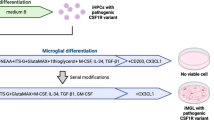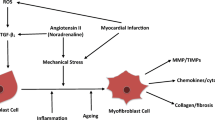Abstract
The immature nucleus pulposus (NP) is populated by cells of notochordal-origin that are larger and contain an extensive cytoskeletal network and numerous vacuoles. The disappearance of these cells with age is believed important in regulating metabolic shifts that may contribute to age-related disc degeneration. The precise biological function of these notochordal cells in the immature NP remains unclear, however, because of challenges in studying the mixed cell population in the NP. In this study, notochordal-like cells were purified from immature NP cells using a new fluorescence-activated cell sorting (FACS) protocol with auto-fluorescence and size analysis. The unique molecular phenotypes of sorted notochordal-like cells were characterized by the mRNA expression pattern for key matrix proteins and modulators, and by the expression of cell–matrix receptor integrin subunits. An FACS analysis showed that the immature NP contained a majority of cells that were larger than anulus fibrosus (AF) cells and with fluorescence higher than AF cells. In comparison with the small NP cells separated by the FACS protocol, sorted notochordal-like cells expressed lower mRNA levels of type I collagen, biglycan, TIMP1, HSP70 and c-fos, and did not express detectable mRNA levels of decorin, lumican, multiple MMPs or IL-1β via real-time quantitative RT-PCR. A greater number of these notochordal-like cells also expressed the higher levels of α6, α1 and β1 integrin subunits as compared to small NP cells. Together, our results point towards a unique molecular phenotype for these notochordal-like cells of NP, characterized by the absence of gene expression for specific small proteoglycans and higher protein expression of integrin subunits that regulate interactions with collagens and laminin. Future studies will be important for revealing if this unique molecular profile is coordinated with functional differences in pericellular matrix regions and/or integrin-mediated cell–matrix interactions for these notochordal-like cells within the NP.




Similar content being viewed by others
References
Aguiar DJ, Johnson SL, Oegema TR (1999) Notochordal cells interact with nucleus pulposus cells: regulation of proteoglycan synthesis. Exp Cell Res 246:129–137
Andersson H, Baechi T, Hoechl M, Richter C (1998) Autofluorescence of living cells. J Microsc 191:1–7
Anidjar M, Cussenot O, Blais J, Bourdon O, Avrillier S, Ettori D, Villette JM, Fiet J, Teillac P, Le Duc A (1996) Argon laser induced autofluorescence may distinguish between normal and tumor human urothelial cells: a microspectrofluorimetric study. J Urol 155:1771–1774
Biyani A, Andersson GB (2004) Low back pain: pathophysiology and management. J Am Acad Orthop Surg 12:106–115
Boyd LM, Chen J, Kraus VB, Setton LA (2004) Conditioned medium differentially regulates matrix protein gene expression in cells of the intervertebral disc. Spine 29:2217–2222
Buckwalter JA (1995) Aging and degeneration of the human intervertebral disc. Spine 20:1307–1314
Chen J, Baer AE, Paik PY, Yan W, Setton LA (2002) Matrix protein gene expression in intervertebral disc cells subjected to altered osmolarity. Biochem Biophys Res Commun 293:932–938
Chen J, Yan W and Setton LA (2004) Biosynthesis of notochordal cells isolated via a novel fluorescence-based sorting protocol. 31st annual meeting of The International Society for Study of the Lumbar Spine, Porto, Portugal, May 30–June 6, paper 7
Fleming A, Keynes RJ, Tannahill D (2001) The role of the notochord in vertebral column formation. J Anat 199:177–180
Gan JC, Ducheyne P, Vresilovic EJ, Shapiro IM (2003) Intervertebral disc tissue engineering II: cultures of nucleus pulposus cells. Clin Orthop Relat Res:315–324
Guilak F, Ting-Beall HP, Baer AE, Trickey WR, Erickson GR, Setton LA (1999) Viscoelastic properties of intervertebral disc cells: Identification of two biomechanically distinct cell populations. Spine 24:2475–2483
Hunter CJ, Matyas JR, Duncan NA (2003) The three-dimensional architecture of the notochordal nucleus pulposus: novel observations on cell structures in the canine intervertebral disc. J Anat 202:279–291
Hynes RO (2002) Integrins: bidirectional, allosteric signaling machines. Cell 110:673–687
Kim KW, Lim TH, Kim JG, Jeong ST, Masuda K, An HS (2003) The origin of chondrocytes in the nucleus pulposus and histologic findings associated with the transition of a notochordal nucleus pulposus to a fibrocartilaginous nucleus pulposus in intact rabbit intervertebral discs. Spine 28:982–990
Maldonado BA, Oegema TR Jr (1992) Initial characterization of the metabolism of intervertebral disc cells encapsulated in microspheres. J Orthop Res 10:677–690
Nettles DL, Richardson WJ, Setton LA (2004) Integrin expression in cells of the intervertebral disc. J Anat 204:515–520
Okuma M, Mochida J, Nishimura K, Sakabe K, Seiki K (2000) Reinsertion of stimulated nucleus pulposus cells retards intervertebral disc degeneration: an in vitro and in vivo experimental study. J Orthop Res 18:988–997
Poiraudeau S, Monteiro I, Anract P, Blanchard O, Revel M, Corvol MT (1999) Phenotypic characteristics of rabbit intervertebral disc cells. Comparison with cartilage cells from the same animals. Spine 24:837–844
Rajpurohit R, Risbud MV, Ducheyne P, Vresilovic EJ, Shapiro IM (2002) Phenotypic characteristics of the nucleus pulposus: expression of hypoxia inducing factor-1, glucose transporter-1 and MMP-2. Cell Tissue Res 308:401–407
Rufai A, Benjamin M, Ralphs JR (1995) The development of fibrocartilage in the rat intervertebral disc. Anat Embryol (Berl) 192:53–62
Taylor JR, Twomey LT (1988) The development of the human intervertebral disc. In: Gosh P (eds) The biology of the intervertebral disc. CRC, Boca Raton, pp 39–82
Trout JJ, Buckwalter JA, Moore KC (1982a) Ultrastructure of the human intervertebral disc: II. Cells of the nucleus pulposus. Anat Rec 204:307–314
Trout JJ, Buckwalter JA, Moore KC, Landas SK (1982b) Ultrastructure of the human intervertebral disc. I. Changes in notochordal cells with age. Tiss Cell 14:359–369
Acknowledgments
We gratefully acknowledge Dr. Mike Cook for assistance with FACS, Dr. Huaxin Sheng and Steve Johnson for assistance with tissue harvesting, and Maureen Upton, Chris Gilchrist, Dana Nettles and Larry Boyd for many helpful discussions. This study was supported by funds from the NIH (AR47442).
Author information
Authors and Affiliations
Corresponding author
Rights and permissions
About this article
Cite this article
Chen, J., Yan, W. & Setton, L.A. Molecular phenotypes of notochordal cells purified from immature nucleus pulposus. Eur Spine J 15 (Suppl 3), 303–311 (2006). https://doi.org/10.1007/s00586-006-0088-x
Received:
Revised:
Accepted:
Published:
Issue Date:
DOI: https://doi.org/10.1007/s00586-006-0088-x




